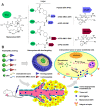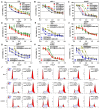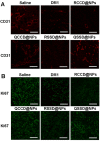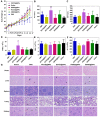A Nanosystem of Amphiphilic Oligopeptide-Drug Conjugate Actualizing Both αvβ3 Targeting and Reduction-Triggered Release for Maytansinoid
- PMID: 28900511
- PMCID: PMC5595133
- DOI: 10.7150/thno.20242
A Nanosystem of Amphiphilic Oligopeptide-Drug Conjugate Actualizing Both αvβ3 Targeting and Reduction-Triggered Release for Maytansinoid
Abstract
To design a prodrug-based self-assembling nanosystem with both ligand targeting and stimuli-responsive features, and elucidate the superiority of each targeting strategy and the synergistic effect between them, we synthesized four small molecule amphiphilic peptide-drug conjugates (APDCs) using maytansinoid (DM1) as a cytotoxic agent, cRGDfK as a homing peptide, and disulfide (SS) or thioether (SMCC) as linker. Owing to their amphiphilicity, the APDCs could self-assemble into nanoparticles (APDC@NPs) which were evaluated in vitro in three different cell lines and in vivo in tumor-bearing C57BL/6 mice. The RSSD@NPs showed the strongest interaction with αvβ3 integrin, highest cell uptake and intracellular free drug level, and best antitumor efficacy in vitro and in vivo, while it shared the same goodness with other test nanosystems in terms of high drug loading, EPR effect and free of potentially toxic polymers. Especially, the in vivo efficacy of RSSD@NPs was 2 fold of free DM1 which is too cytotoxic to be a drug, while the active targeted APDC@NPs demonstrated acceptable system, tissue and blood compatibility. In αvβ3-positive cells or tumors, the RGD targeting contributed much more than disulfide in anticancer effect. The maximum synergism of the two strategies reached to 22 fold in vitro and 3 fold in vivo. Generally, the active targeting, prodrug and nanosystem could significantly decrease the toxicity of free DM1 and improve its therapy outcome via combining active targeting, prodrug and nanopreparation, especially the dual targeting strategies and their synergism.
Keywords: Amphiphilic peptide-drug conjugate; antitumor therapy.; endocytosis; maytansinoid DM1; reduction-triggered drug release; αvβ3-targeted nanoparticles.
Conflict of interest statement
Competing Interests: The authors have declared that no competing interest exists.
Figures







Similar articles
-
A comparative study of the antitumor efficacy of peptide-doxorubicin conjugates with different linkers.J Control Release. 2018 Apr 10;275:129-141. doi: 10.1016/j.jconrel.2018.01.033. Epub 2018 Feb 2. J Control Release. 2018. PMID: 29408580
-
αvβ3 Integrin-targeted reduction-sensitive micellar mertansine prodrug: Superb drug loading, enhanced stability, and effective inhibition of melanoma growth in vivo.J Control Release. 2017 Aug 10;259:176-186. doi: 10.1016/j.jconrel.2016.12.011. Epub 2016 Dec 14. J Control Release. 2017. PMID: 27986551
-
A Smart Nano-Prodrug Platform with Reactive Drug Loading, Superb Stability, and Fast Responsive Drug Release for Targeted Cancer Therapy.Macromol Biosci. 2017 Oct;17(10). doi: 10.1002/mabi.201600518. Epub 2017 May 2. Macromol Biosci. 2017. PMID: 28464449
-
Targeted cancer therapy: conferring specificity to cytotoxic drugs.Acc Chem Res. 2008 Jan;41(1):98-107. doi: 10.1021/ar700108g. Epub 2007 Aug 18. Acc Chem Res. 2008. PMID: 17705444 Review.
-
αvβ3 Integrin-Targeted Peptide/Peptidomimetic-Drug Conjugates: In-Depth Analysis of the Linker Technology.Curr Top Med Chem. 2016;16(3):314-29. doi: 10.2174/1568026615666150701114343. Curr Top Med Chem. 2016. PMID: 26126915 Review.
Cited by
-
Research advances in peptide‒drug conjugates.Acta Pharm Sin B. 2023 Sep;13(9):3659-3677. doi: 10.1016/j.apsb.2023.02.013. Epub 2023 Feb 28. Acta Pharm Sin B. 2023. PMID: 37719380 Free PMC article. Review.
-
Ultrasound-mediated delivery of RGD-conjugated nanobubbles loaded with fingolimod and superparamagnetic iron oxide nanoparticles: targeting hepatocellular carcinoma and enhancing magnetic resonance imaging.RSC Adv. 2020 Oct 27;10(64):39348-39358. doi: 10.1039/d0ra06415g. eCollection 2020 Oct 21. RSC Adv. 2020. PMID: 35518389 Free PMC article.
-
Maytansinoids in cancer therapy: advancements in antibody-drug conjugates and nanotechnology-enhanced drug delivery systems.Discov Oncol. 2025 Jan 21;16(1):73. doi: 10.1007/s12672-025-01820-z. Discov Oncol. 2025. PMID: 39838217 Free PMC article. Review.
-
Prostate-Specific Membrane Antigen and Esterase Dual Responsive Camptothecin-Oligopeptide Self-Assembled Nanoparticles for Efficient Anticancer Drug Delivery.Int J Nanomedicine. 2021 Dec 3;16:7959-7974. doi: 10.2147/IJN.S331060. eCollection 2021. Int J Nanomedicine. 2021. PMID: 34887660 Free PMC article.
-
Maytansinol Derivatives: Side Reactions as a Chance for New Tubulin Binders.Chemistry. 2022 Jan 10;28(2):e202103520. doi: 10.1002/chem.202103520. Epub 2021 Nov 29. Chemistry. 2022. PMID: 34788896 Free PMC article.
References
-
- Choi KY, Yoon HY, Kim JH. et al. Smart nanocarrier based on PEGylated hyaluronic acid for cancer therapy. ACS Nano. 2011;5(11):8591–8599. - PubMed
-
- Mikhaylov G, Mikac U, Magaeva AA. et al. Ferri-liposomes as an MRI-visible drug-delivery system for targeting tumours and their microenvironment. Nat Nanotech. 2011;6(9):594–602. - PubMed
Publication types
MeSH terms
Substances
LinkOut - more resources
Full Text Sources
Other Literature Sources
Research Materials

